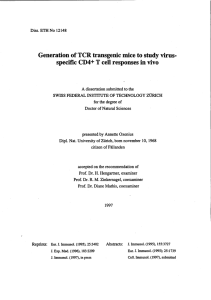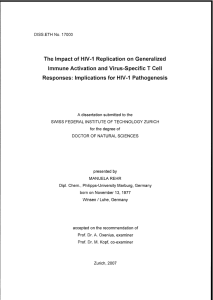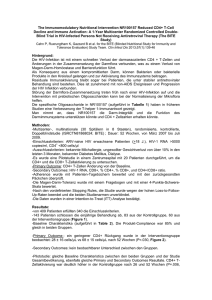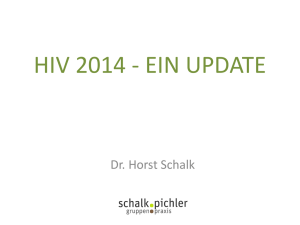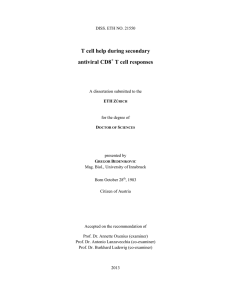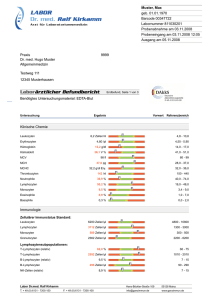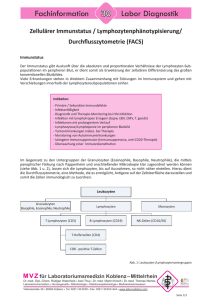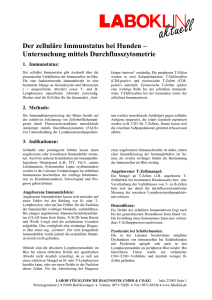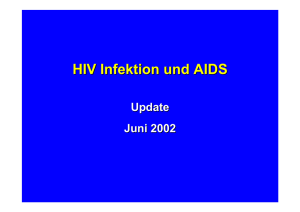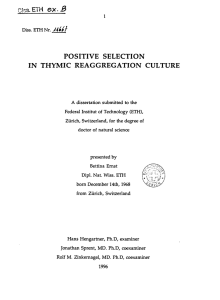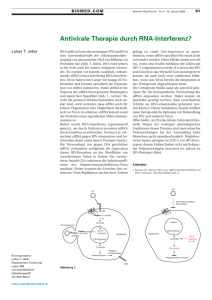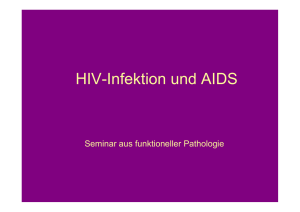CD4 T Cell Response during MCMV Infection - ETH E
Werbung
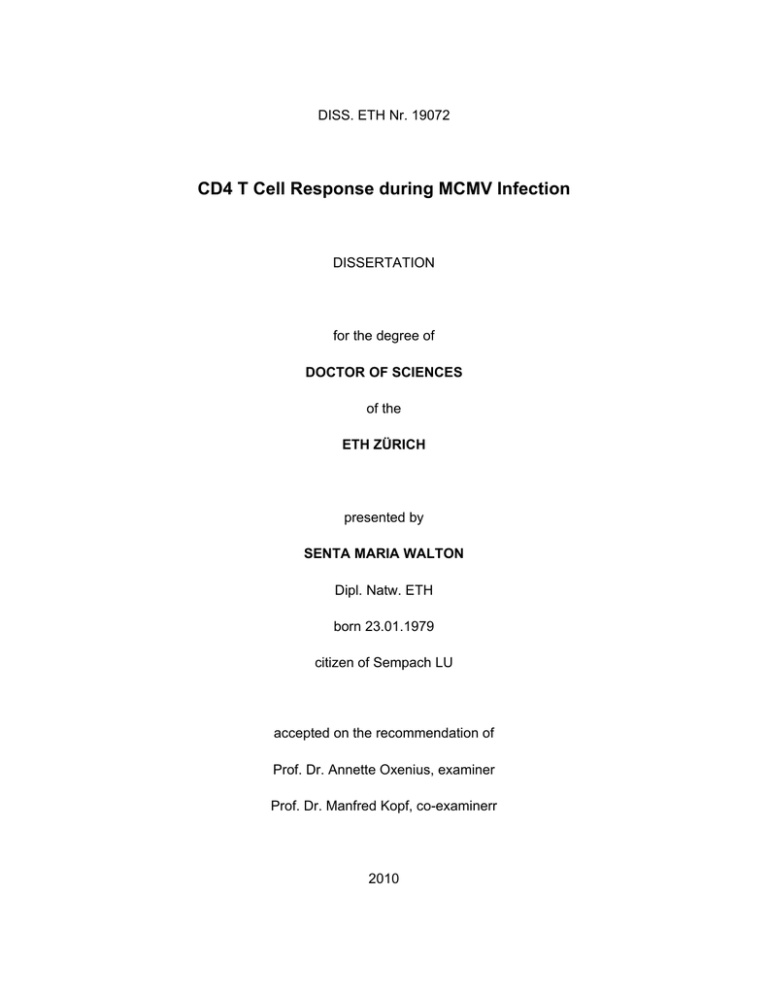
DISS. ETH Nr. 19072 CD4 T Cell Response during MCMV Infection DISSERTATION for the degree of DOCTOR OF SCIENCES of the ETH ZÜRICH presented by SENTA MARIA WALTON Dipl. Natw. ETH born 23.01.1979 citizen of Sempach LU accepted on the recommendation of Prof. Dr. Annette Oxenius, examiner Prof. Dr. Manfred Kopf, co-examinerr 2010 Summary 1. Summary Cytomegaloviruses (CMVs), members of the β-herpesvirinae family, establish a persistent and latent infection. Seroprevalence in the human population varies between 50 to 90 % dependent on socio-cultural factors. Although CMV infections are generally clinically silent in individuals with an intact immune system, primary infection or reactivation from latency in the immunocompromomised hosts can lead to severe morbidity and even mortality. These viruses are controlled not only by the innate but also by the adaptive part of the immune system. Several immune cells are redundantly involved in the immune surveillance, most prominently natural killer (NK) cells, T and B cells. As a consequence impairment in a single immune cell subset has mostly only a marginal if any impact on viral loads. As an exception CD4 T cells are absolutely crucial for the cessation of overt viral replication and the establishment of latency especially in the salivary glands. In spite of the importance of this cell subset its exact role remains ill-defined in the context of CMV infection. In this PhD thesis we used the mouse as a model system to investigate these potent antiviral immune cells. We first identified CD4 T cell epitopes specific for mouse CMV (MCMV) to study in detail the kinetics of MCMV-specific CD4 T cell responses and their cytokine secretion profile. In later studies we delineated the functional mechanisms how CD4 T cells can confer protection from MCMV and how they influence the MCMV-specific CD8 T cell responses. Finally we generated transgenic mouse lines expressing a T cell receptor (TCR) specific for the immunodominant CD4 T cell epitope M25410-425 in the context of I-Ab. To characterize MCMV-derived CD4 T cell epitopes we generated CD4 T cell hybridomas which were then screened for their MCMV, protein and finally epitope specificity. The protein specificity could be evaluated from 9 out of 26 MCMV-specific hybridomas recognizing in total 4 different proteins and 5 individual epitopes. Analysis of their kinetic responses demonstrated that they peak around one week post primary infection, contract sharply thereafter and finally stabilize at low levels during latency. Memory inflation as published for MCMV-specific CD8 T cells and CMV-specific CD4 T cells in humans, however, was not observed during MCMV persistence and latency for MCMV-specific CD4 T cells. This cell subset displays a typical Th1 phenotype expressing high amounts of IFNγ and TNFα as well as IL-2. Although the importance of CD4 T cells for the control of MCMV replication was already demonstrated over two decades ago, the exact protective mechanisms exerted by this cell 3 Summary subset has not been directly addressed yet. In the absence of CD4 T cells cessation of overt MCMV replication is delayed in several organs and cannot be achieved at all in the salivary glands. Using mixed bone marrow chimeras we can demonstrate for the first time that IFNγ secreted directly by CD4 T cells is responsible for the protective capacities of these cells during MCMV infection. Further, this cytokine acts directly on infected or bystander non-hematopoietic cells suppressing viral replication or rendering them unresponsive to subsequent MCMV infection, respectively. Currently we are investigating the exclusiveness of IFNγ production by CD4 T cells and why IFNγ secreted by other immune cells such as MCMV-specific CD8 T cells cannot compensate for the lack of CD4 T cells. We suggest that in the salivary glands MCMVspecific CD8 T cell epitopes, in contrast to CD4 T cell epitopes, are not presented by antigen presenting cells (APCs) or that CD8 T cell functions are inhibited rigorously by immune suppressive mechanisms e.g. myeloid suppressor cells. It was demonstrated previously for a variety of acute resolved infections and after immunizations that CD8 T cells rely on CD4 T cell help. However their degree of dependence on CD4 T cell help varies according to the pathogen and immunization protocol. Additionally CD8 T cells are adversely affected by sustained high antigen loads. We surprisingly demonstrate that increased viral replication in the absence of CD4 T cells partially maintains and not exacerbates the high percentages of MCMV-specific CD8 T cells observed during latency and that CD4 T cells are necessary for the functionality as well as long term maintenance of MCMV-specific CD8 T cells. Exact helper mechanisms exerted by CD4 T cell are currently under investigation. Finally we generated TCR-transgenic mouse lines whose CD4 T cells specifically recognize the immunodominant epitope M25410-425. In future experiments we will use these mouse lines to investigate in more details the characteristics of these potent antiviral effector cells during acute, persistent and latent MCMV infection. 4 Zusammenfassung 2. Zusammenfassung Cytomegaloviren (CMV) gehören zu den β-Herpesviren und etablieren wie andere Mitglieder dieser Familie eine persistente, latente Infektion. Die Seroprevalenz in der Bevölkerung ist abhängig von soziokulturellen Strukturen und variiert zwischen 50 und 90%. Obwohl die primäre MCMV Infektion in Individuen mit einem intakten Immunsystem generell klinisch ruhig verläuft, kann die Erstinfektion, aber auch eine Reaktivierung von latentem CMV, im immunkompromittierten Wirt zu erheblichen medizinischen Komplikationen und sogar zum Tode führen. Nicht nur das angeboren sondern auch das adaptive Immunsystem ist erheblich an der Kontrolle von CMV beteiligt. Mehrere Immunzellen sind redundant in der Immunabwehr involviert, vor allem B, T Zellen und natürliche Killerzellen. Diese Redundanz hat zur Folge, dass die Einschränkung einzelner Immunzelltypen keinen oder nur einen geringen Einfluss auf die Viruslast hat. Eine Ausnahme bilden die CD4 T Zellen, deren Abwesenheit eine Erhöhung der viralen Titer und das Aufheben der CMV Kontrolle in den Speicheldrüse zur Folge hat. Obwohl den CD4 T Zellen eine solch bedeutende Rolle innewohnt, sind sie im Kontext von CMV bisher nur spärlich untersucht worden. In dieser Doktorarbeit wurden daher diese potenten antiviralen Immunzellen im Mausmodel mit der Maus-CMV (MCMV) Infektion genauer untersucht. Zuerst haben wir MCMV-spezifische CD4 T Zellepitope identifiziert, an Hand deren wir die Kinetik von MCMV-spezifischen CD4 T Zellen und deren Zytokinprofile im Detail untersucht haben. Danach fokussierten wir unsere Arbeit auf die Identifizierung der funktionellen antiviralen Mechanismen von CD4 T Zellen und wie CD4 T Zellen MCMVspezifische CD8 T Zellen beeinflussen. Zuletzt wird in dieser Doktorarbeit die Herstellung einer transgenenen Mauslinie beschrieben, welche einen T Zellrezeptor exprimiert, der spezifisch das immundominant MCMV CD4 T Zellepitope M25410-425 im Kontext von I-Ab erkennt. Zur Identifizierung von MCMV-spezifischen CD4 T Zellepitopen stellten wir zuerst CD4 T Zellhybridome her, welche wir auf deren MCMV, Protein und Epitope Spezifität prüften. Von den insgesamt 26 MCMV-spezifischen CD4 T Zellhybridomen konnten wir für neun eine Protein und Epitopespezifität zuweisen, welche total vier MCMV-Proteine und wiederum fünf verschiedene Epitope beinhalten. Die MCMV-abhängige CD4 T Zellantwort erreicht ihren Höhepunkt eine Woche nach der Primärinfektion, nimmt danach stark ab und stabilisiert sich während der Latenz auf einem relativ niedrigen Niveau. Ein kontinuierliche Erhöhung der Frequenz während der Persistenz oder Latenz wie bereits gezeigt für die MCMV-spezifische CD8 T Zellantwort und die humane CMV-spezifische CD4 T Zellantwort konnte jedoch nicht 5 Zusammenfassung festgestellt werden. Die untersuchten MCMV-abhängigen CD4 T Zellen weisen einen typischen Th1 Phenotyp auf mit hoher Sekretion von IFNγ, TNFα und IL-2. Obwohl schon seit mehr als zwei Jahrzenten bekannt ist, dass CD4 T Zellen absolut essentiell sind für die Kontrolle der CMV Replikation vor allem in der Speicheldrüse, wurde bis heute noch nie untersucht, wie genau CD4 T Zellen die virale Replikation unterbinden. Wir können nun zum ersten Mal zeigen, dass die IFNγ Produktion von CD4 T Zellen essentiell ist für die antivirale Funktion dieses Zelltyps. Des Weiteren bindet dieses Zytokin direkt an infizierte Zellen oder nicht-hämatopoietische Nachbarszellen, um die virale Replikation in diesen Zellen entweder zu hemmen oder eine Neuinfektion zu verhindern. Momentan versuchen wir zu verstehen, wieso IFNγ, produziert von anderen Immunzellen, die Abwesenheit der CD4 T Zellen nicht kompensieren kann. Es wurde bereits für verschiedene andere akute Infektionen wie auch nach Immunisierung gezeigt, dass Antigen-spezifische CD8 T Zellen abhängig sind von CD4 T Zellhilfe. Zusätzlich verschlechtert sich die Funktionalität von pathogen-spezifischen CD8 T Zellen, wenn sie chronisch einer hohen Antigenlast ausgesetzt sind. Als wir die Helferfunktion von CD4 T Zellen während der MCMV Antwort untersuchten, konnten wir überraschenderweise feststellen, dass infektiöses Virus für die Aufrechterhaltung einer hohen MCMV-spezifischen CD8 T Zellantwort absolut wichtig ist. CD4 T Zellen sind zudem verantwortlich für die Aufrechterhaltung einer robusten CD8 T Zellantwort über eine längere Zeit und deren Funktionalität. Zur Zeit versuchen wir den exakten Helfermechanismus zu evaluieren. Schlussendlich haben wir T Zellrezeptor transgene Mauselinien hergestellt, deren CD4 T Zellen das MCMV-spezifische CD4 T Zellepitop M25410-425 erkennen. In zukünftigen Experimenten werden wir diese Mauslinie benutzen, um die Charakteristiken der antiviralen CD4 T Zellen während der akuten, persistenten und latenten MCMV Infektion im Detail zu untersuchen. 6
